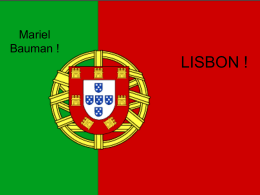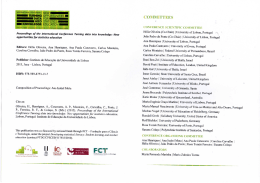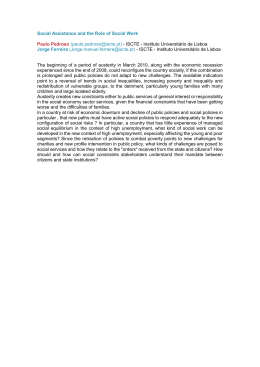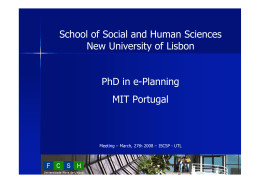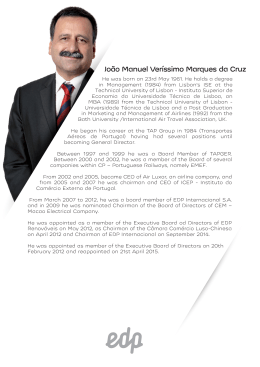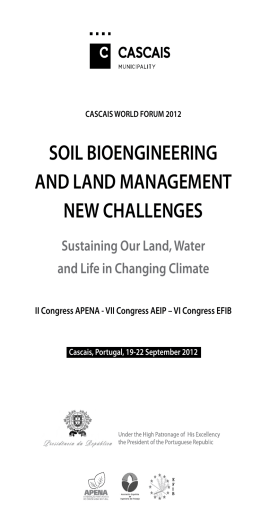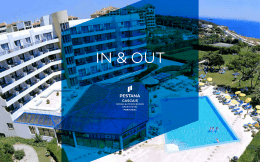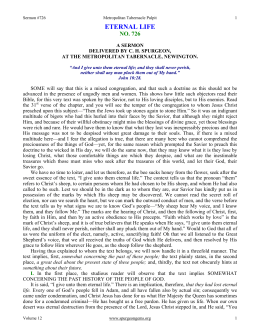a r Cristina t e Carvalho s • The e spiritual h quest: u m europe’s common a n sacred i ground d a (an d e historic s overview) The spiritual quest: Europe’s common sacred ground (an historic overview) 1 Cristina Carvalho Escola Superior de Hotelaria e Turismo do Estoril Resumo A procura espiritual da Humanidade permanence activa e as perspectivas académicas sobre o fenómeno são múltiplas. Na Europa a reverência a poderes supremos começou em grutas e seria depois exibida em estruturas exteriores. Mais tarde, os Gregos Antigos deslocar-se-iam a competições atléticas onde os deuses eram adorados, mas o Cristianismo apagaria as referências pagãs do Império Romano. Quanto à Península Ibérica do século XII, São Bernardo auxiliou a fundação de Portugal, enquanto crentes viajavam até Santiago de Compostela. Durante as Descobertas, o porto de Lisboa acolheu tesouros ultramarinos, mas também a Peste. Duas devoções surgiram para implorar a clemência de Deus: a peregrinação à Guia, em Cascais, e a procissão à Senhora da Saúde. No século XVIII, D. João V patrocinaria santuários marianos em Lamego, na Nazaré e no Cabo Espichel, mas só na ditadura de Salazar erguer-se-ia um santuário de dimensão global, em Fátima. Desde a década de 60 que a Europa testemunha o revivalismo pagão que transformou sítios arqueológicos da UNESCO em templos New Age. Hoje, o adorador virtual assiste a missas online em portáteis com placa wireless, prova de que a procura se mantém, sobrepondo-se aos meios empregues. Palavras-Chave História, Turismo, Demanda (Espiritual), Europa, Adorador virtual Abstract Mankind’s spiritual quest is still on and the academic perspectives upon the matter are manifold. In Europe, the reverence towards higher powers began inside caves and was later displayed on open-air structures. Then the Ancient Greeks journeyed to attend athletic games where the gods were worshiped, but Christianity would strife to erase Pagan references across the Roman Empire. As for the 12th century Iberian Peninsula, St. Bernard persevered for Portugal’s foundation, while believers travelled to Santiago de Compostela. During the Discoveries Lisbon’s harbour welcomed overseas treasures and also the Plague. Two devotions were created in order to beg for God’s mercy: the pilgrimage to Guia in Cascais, and the procession to Our Lady of Health. In the 18th century, John V sponsored Marian sanctuaries at Lamego, Nazaré and Cape Espichel, but Fátima’s large173 exedra • nº 6 • 2012 scale sanctuary was only erected during Salazar’s dictatorship. Since the 1960s Europe witnesses the revival of Paganism that turned UNESCO archaeological sites into New Age temples. The contemporary techno-worshipper attends online masses on wireless laptops, proving that despite the means the quest remains unchanged. Keywords History, Tourism, (Spiritual) Quest, Europe, Techno-worshiper Introduction While some scholars commit themselves to debate the economic, sociological and urban impacts tourism has on sacred sites focusing on «Cause and Effect» matters, historians prefer to work as «memory collectors», gathering information on the «When, Who and Why», according to the different stages of evolution of societies. In order to best understand the present one must know the past, also as a means to prepare the future. This study will not focus on a case study per se, but rather travel through Time, recalling Europe’s spiritual quest from Pre-historic days up to now. This memory exercise will be conducted with the assistance of several written sources on the matters of Religion, Spirituality and Tourism, aiming at organising the puzzle of Human devotion throughout the ages across Europe. One hopes to innovate within the topics of discussion by pin pointing how recently technology has managed to win its place at the heart of contemporary believers, proving that Man’s spiritual quest is still on. In the Beginning... Mankind’s reverence towards higher and cosmic powers began at the dawn of human presence on Earth inside caves, and was later displayed on open-air stone structures known as megaliths. At an early stage pre-historic caves were decorated with rupestrial art that turned the sites into a sort of temples meant to unite a local community into a cult2, as one may behold at Lascaux, in France, Altamira, in Spain, and Escoural, in Portugal. Several were also the fertility statuettes of Venuses found in Europe as the Venus of Laussel (France) or the Venus of Willendorf (Austria). With prominent breasts and round bellies, these «lucky charms» were but a material representation of the deeper abstract female principle of seasonal fertility, which was connected to the cycles of Nature that were visually reflected on the prosperity of the Great Mother (Mother Earth or the Goddess). Yet, Earth was not the only surrounding element that received early devotional manifestations, since the sky above was also a great source of wonders and wanders. 174 Cristina Carvalho • The spiritual quest: europe’s common sacred ground (an historic overview) Currently, science is finally unveiling what the Ancient already knew or, at least, sensorially perceived. According to Loução (2002), Geobiology has proved the Hartmann Network (from N/S and E/W) and the Curry Network (obliquous angles) cross the Earth, and most megalithic monuments have been erected under the magnetic influence of both.3 England’s most famous megalithic sites are located at Salisbury Plain, which, according to Carr-Gomm (2008), has 450 monuments and the two ritual landscapes of Avebury and Stonehenge4, along with crop circles still left to decipher5. Of the several legends and theories created around the cromlech of Stonehenge, Alexander (2008) refers that the experts now agree that Stonehenge’s altar was aligned to be the focal point of sunrise during the Summer Solstice and of sunset at Winter Solstice. However, recalling Geoffrey of Monmouth’s reference to the interference of Merlin, the Wizard who brought the blue (feldespat) stones from Wales to this healing site at Salisbury Plain, Alexander also informs us that there is still a timeless belief that the water springing from the Preseli mountains has healing properties, turning Stonehenge into a kind of Lourdes for the pre-historic world6. Carr-Gomm supports also that currently Stonehenge and neighbouring Avebury “in addition to being tourist attractions... have also become places of pilgrimage to contemporary Pagans”.7 Speaking of Paganism, the Lusitanians were one of the many Celtic tribes that inhabited the current Portuguese territory and that worshipped the natural forces like the sun, the moon, the stars and the wind, and as Amarante (1995) indicates “they had places of worship and sanctuaries placed on mountain tops or close to water springs”8. Close to Lisbon, Sintra mountain9 was one of the holiest places for the Celts in Portugal, but seafarers had already previously revered its holiness, for travellers like the Greeks and the Celtic-Gauls had built and worshiped at a temple devoted to the Moon10. For the Romans, Sintra was Ofiússa, the Land of the Serpents, referring to the druids that conducted Pagan rituals in the woods.11 In the meantime, around the Mediterranean Sea the Oracle of Delphi developed from a Bronze Age goddess sanctuary at Mount Parnassus into a temple devoted to Apollo, god of healing. The Oracle was a great pilgrimage centre until Roman emperor Theodosius had it shut down in the 4th century AD, for being anti-Christian. Yet, as CarrGomm indicates, “for nearly 1.000 years visitors would travel from far and wide to consult the priestesses on matters that troubled them. They would arrive either by ship in the harbour below at Kirrha or by land across the Plain of Thessaly”12. The Oracle had been defined by Zeus, the God of gods who released two eagles from opposite ends of the Earth and their meeting point became the navel of the world, the Omphalos, where Pythia, the snake, would be later defeated by Apollo, and where the Pythian Games occurred to honour 175 exedra • nº 6 • 2012 him. Ancient Greece was an ensemble of self-governed cities that constantly battled each other, and even when the rivalry did not imply the shedding of physical blood, it would imply the moral submission of those defeated at athletic events. Back then, the mega events and venues were a way of worshipping the gods, humiliating other cities, yet, preserving a common culture that praised the union of healthy body and mind. As Hudson (2003) recalls “groups of city states came together for the many festivals particularly the Olympic Games13, the Pythian Games, and the Isthmian Games”14. The Games honoured: 1 - Zeus – every 4 years, at Mount Olympus; 2 - Apollo – every 2 years, at Mount Parnassus; 3 - and Poseidon – every 1st and 3rd years after the Olympics, at the Isthmus of Corinth. There were also «minor» games to Athena (Pan-Athenian Games) and Hera (Herean Games). All these flows of temporary visitors explain the existence of hostels along the ways, besides vendors and tour guides at the venues, thus creating what is now known as «Hospitality Industry». One must also refer that in 204 BC a statue of Magna Mater, a deity from Asia Minor, was transported to Rome after the orders granted by the Oracle of Delphi. The assimilation of local cults was a common practice all over the Roman Empire before Christianity was declared the official religion of Rome. Therefore, it is easy to understand how Egyptian cults like that to Isis, the protector of Motherhood and Fertility, travelled from the Mediterranean area into the north of Portugal. Braga’s cathedral was built over the remnants of a previous temple to Isis, for a statue of the goddess holding baby Horus in her lap has been dug up there. One must also refer the existence of similar goddesses in the Middle East like the Babylonian Ishtar and the Phoenician Astarte, which is why Christianity would easily spread the devotion to Our Lady as that of a mother nurturing her child. As Ambrósio (2000) states, in 431 the Council of Ephesus, in Turkey, defined the Virgin Mary as the «Mother of God», leading to the construction of sanctuaries and to pilgrimages, first in Eastern, then in Western Europe15. For Loução, the coincidence of Isis being portrayed holding her son, who had also been born on the day of the Winter Solstice was, much like the building of chapels on timeless sacred mountains, “another example of forced Christianization”.16 176 Cristina Carvalho • The spiritual quest: europe’s common sacred ground (an historic overview) From the Middle Ages onwards The Fall of the Roman empire, the invasion of Barbaric tribes and of the North African Moors to the Iberian Peninsula plunged Europe into what is still known as the «Dark Ages», but Christianity managed to survive and regain its primacy thanks to the spiritual leadership of men like St. Bernard of Clairvaux, member of the Cistercian Order and «Godfather» of the Knights Templar, in the 12th century, and of St. Francis Assisi, in the 13th century. Both Cistercians and Franciscans defended the role of the Virgin Mary as a humble woman that bore the son of God. Speaking of Portugal, authors like Pedro Silva (2007) defend this country was founded thanks to three great 12th century influences: those of St. Bernard (a powerful ally to Afonso I before the Vatican), of the Knights Templar (who assisted Portugal’s 1st king to defeat the Infidels and create a territorial unity under God), and of the widespread devotion to Our Lady17. In the following century, Portugal would give the world the preaching genius of St. Anthony, a Franciscan who had been born in Lisbon in 1195, but died in Italy (Padova) in 1231, which is why even now he is mistakenly taken as an Italian saint. During the Middle Ages many were the European sanctuaries that attracted pilgrims thanks to the tombs of saints like St. James, in Compostela (Spain), St. Thomas Becket, in Canterbury (England), or to the transformation of former Pagan sites into Christian temples to Our Lady, like Chartres cathedral (France). In spite of the ultimate mystic aura being connected to the Holy Land, the lack of safety conditions to travel only permitted a small portion of «Europeans» to actually go there. Thus, European towns like Canterbury18, Compostela, Rome or Venice became key destinations for crowds of sufferers from all walks of life that would travel for weeks searching for the means to appease body and soul. As Feifer (1986) writes, “by the thirteenth and fourteenth centuries, pilgrimage was a mass phenomenon... served by a growing industry of networks of charitable hospices”.19 Located in Spain, Saint James’ sanctuary was a safer alternative to Jerusalem, therefore, “from Britain, Ireland and northern Europe many took the journey partly by boat, while others walked or rode by horse or donkey along one of the four traditional routes through France”20. It became so popular that a sort of «Travellers’ Guide» called The Pilgrim’s Guide would even appear in 1140 to advise pilgrims over the routes and site. The route was based on the existence of hospitality facilities, legends and even iconographic symbols connected to St. James. Feifer explains that even the purchase of souvenirs became an economic activity, for pilgrims could choose between finding their own scallop at beaches or buying it at Compostela’s stores, for this «brand» became “the most popular and distinctive memento of the time”21. Despite the following setbacks 177 exedra • nº 6 • 2012 connected to the access to the sanctuary, the truth is that after the 2nd World War the pilgrimages regained popularity to such an extent that in 1987 the Council of Europe declared the Way the 1st European Cultural Route. The promotion of that decision was also reinforced thanks to the success of Brazilian writer Paulo Coelho’s book The Pilgrimage, the official designation of 1999 as a Holy Year for Compostela, and 2000 as the Year of the Roman Jubilee. Howard (2003) sustains that the Camino to Santiago de Compostela was actually the 1st of many European paths planned, but also recalls that currently “a common European culture is being forged more on the crowded beaches of the Costa del Sol, the campsites of France, in the festivals at Salzburg and on the tourist trail at Rome”22. On the other hand, Carr-Gomm makes reference to Brian Sewell, a British Catholic who in 2003 made a TV series, The Naked Pilgrim, where he presented his journey to Compostela; alongside his scepticism, “Sewell conveyed the idea that in essence a pilgrimage is a journey that involves freeing oneself of attachments of every kind until one stand ‘Naked before God’”.23 As for Chartres cathedral, Sierra (2008) recalls its Pagan foundations, but also the preservation of a daedalus, a sort of labyrinth inspired in the Minoan legend of the Minotaur, that the Ancients named as «Jerusalem Mile»: instead of travelling down to the Holy Land, the believers could walk over it standing on their knees, in order to obtain a similar spiritual fulfilment24. Carr-Gomm indicates even that “since 1982 15,000 or more supporters of a return to the traditional Latin Mass have undertaken a three-day long walk from Paris to the cathedral every Pentecost (the fiftieth day after Easter Sunday)”.25 The Reformation and the Counter-Reformation were two important spiritual and political earthquakes that moulded Europe into two main spheres of influence: the Protestant nations from the north, and the Catholic countries from the south. If in England 1538 settled the year when pilgrimage sites were to be erased for good, between 1545 and 1563 the Holy See «counter-attacked» with the guidelines defined at the Council of Trent. In the 1st case, Strong argues that the destruction was so fiercely performed; it felt that “a way of life which had existed for a thousand years suddenly extirpated”.26 As for Portugal, the country was much more engaged in the overseas voyages of exploitation (the Discoveries Age), than on the religious commotion of Central Europe, but it remained loyal to Rome. If the cosmopolitanism of Lisbon’s harbour was a great source of income to the royal exchequer, it was also a source of constant grief since the downside of the arrival of exotic treasures were the recurrent outbreaks of plague, mainly since Vasco da Gama had paved a safe «maritime highway» between Lisbon and India, in 1498. In order to request God’s mercy in 1518 Lisbon’s authorities forged the pilgrimage to the Guia hermitage (devoted to Our Lady of Guidance), in Cascais, and the procession to Our Lady of Health (the latter is still performed in one of Lisbon’s oldest 178 Cristina Carvalho • The spiritual quest: europe’s common sacred ground (an historic overview) quarters). In spite of the c.25 km that separate the capital from Cascais, D’Encarnação (2002) mentions “first, by boat, and then, on foot, Lisbon’s people came to Cascais, where local inhabitants would join them on the quest for the Guia”27. The growth of the temple’s importance explains why there was the need to build a bigger one in 1573, but in 1834 the liberal government extinguished all convents and monasteries, and most pilgrimages ceased to be organised, like that of Guia. On the other hand, in 1570 king Sebastian allowed the creation of a procession to honour Our Lady of Health by those who were thankful for their lives after the dreadful outbreak of the previous year, namely the gunners at Lisbon’s castle regiment. Formerly sponsored by queens, this early May procession is still the capital’s most vivid religious tradition, including members of the Army, Police and Fire departments, besides Lisbon’s Cardinal-Patriarch and the country’s 1st Lady. Once again reference must be made to the Marian cult in Portugal, not only because of its everlasting acceptance, but also because of a political power play conducted by king John IV. After 60 years of Spanish Domination between 1580 and 1640, in 1646 John IV managed to have the Holy See declare that Portugal’s new patroness was now Our Lady of Conception. Indirectly, by accepting Her as leader of Portugal’s fate, Peter’s Throne was acknowledging the Braganza family as the lawful rulers of Portugal, for Our Lady had always been their patroness, too. In the 18th century John V sponsored the construction and/or journeyed as pilgrim to the Marian sanctuaries located uphill in Lamego, and at the headlands of Espichel and Nazaré. In Portugal alone, Nolan and Nolan’s 1989 chart on Christian sanctuaries located in Western Europe has accounted for 321 in Portugal, 168 of which are solely devoted to Our Lady, representing 52% of the total.28 Yet, Portugal’s large-scale pilgrimage centre did only progressively rise in Fátima during the 20th century. On the 13th May 1917 a shinning Lady appeared to three children, actually shepherds, at the moorlands of Cova da Iria, a dry rocky landscape punctuated with low quality pastures and a few holm-oaks. Unaccepted by the authorities because of the anticlericalism of Portugal’s 1st Republic (1910/1926), the belief on the apparitions that occurred from May to October 1917 would be implemented by the Dictatorship that lasted until 1974. Salazar believed religion could be used as a means to reinforce his political agenda on the Portuguese: God, more specifically Fátima, could «work» on behalf of the New State he now led (mainly during the Spanish Civil War). Regardless of scientific explanations to the phenomena that occurred during the Summer of 1917, like that of Sierra to whom the sensitive poor children were only affected by magnetic disturbances29, the truth is that Fátima’s sanctuary keeps on hosting thousands of pilgrims every year. Official data provided by the Internet site of 179 exedra • nº 6 • 2012 the Sanctuary indicates that in 2005 it celebrated 2,544 masses, which were attended by 3. 415,079 people30. In 2007 it witnessed the inauguration of a church that has 9,000 seats, 46 confessional boxes, a congress centre and Media facilities, thus allowing the growth of these numbers. More recently, on the 13th October 2009, the sanctuary’s internet site indicated the presence of 100,000 pilgrims31 to attend the field mass that closed the main period of attendance connected to the 1917 apparitions, ranging from May to October. What about now? In Europe, the 1960s witnessed the revival of Pagan practices that turned archaeological sites into New Age temples. Along with Stonehenge, Glastonbury’s pilgrims are to be understood according to the double aspect of the site: its Pagan and Christian connotations. As Carr-Gomm explains, Glastonbury “is a place of meeting... the essence of Paganism and Christianity, which merge in the story of the grail32, and of the God and Goddess embodied in Glastonbury Tor and Chalice Hill”33. As far as Stonehenge is concerned, in 2001 Chippindale and Davidson wrote a discussion paper in which they defend that the site welcomes more than 800,000 visitors per year34 (these numbers leave out all the onlookers who only take a peak over the fence and not pay for the entrance at the complex). More recently, the online edition of the BBC News Channel dating from the 21st June 2009 reported that a record number of 36,500 people35 went there to celebrate Summer Solstice. For Drury (2003), the advent of Feminism in the 1960s led to the rise of witchcraft practices and of “Nature-based religion with the Great Goddess as its principal deity”36. Since the 1604 British Witchcraft Act was repealed in 1951, people like Gerald Gardner and Alex Sanders could now publish books and start namesake Wiccan traditions during the following decades. However, as Cowan (2003) defends we do not live as intimately with nature as did the remote nineteenth-century Scottish Highlanders. Our own lives are embedded in the modern conveniences and technologies that separate so much human activity, thinking, and feeling from the natural world.37 In fact, by the end of the 20th century technology started taking over man’s leisure moments and labour time, but also his own spiritual dimension. The Internet allowed us to discover cyberspace, where people can interact with no physical constraints, which is why Neo-Pagans started sharing beliefs and rites, and even conducting rituals over a 180 Cristina Carvalho • The spiritual quest: europe’s common sacred ground (an historic overview) mere computer38. On an interview to Drury, Sara Reader explained that while Christians and other mainstream religions ignored the Net for years... we became the first religious movement to depend heavily on it for growth and cohesion. And cyberspace, in turn, became the first mass Pagan gathering place since ancient times.39 At the beginning of the 21st century, the contemporary «techno-worshipper» is a person of any spiritual belief that attends online services on wireless laptops, anywhere across the world. Perceiving the need to keep up with times, even Christian sanctuaries like Fátima have now, not only an Internet site of its own, but also the performances of online masses to worldwide Catholics. Drury ultimately sustains that man’s spiritual quest “will remain an eclectic journey to self-knowledge and transcendence, enabling each individual to find a sense of sacred meaning in his or her own way”40. On his sci-fi book Contact, scientist Carl Sagan wrote, “most people got separated from the sky on a cosmism isolationism that only ended at the dawn of space exploration”41. Despite the means one may choose to worship the Almighty (contact with nature, visits to man-made sacred sites, cybernetic navigation), all in all, the quest remains unchanged after thousands of years of human life on Earth. In 1994 Carvalho-Oliveira and Cymbron defended that, in Portugal, “religious tourism, mainly domestic tourism, should take more advantage of Portuguese saints”42, namely, Saint Anthony in Lisbon, Saint Teotonius in Viseu, Holy Queen Elizabeth in Coimbra, and Saint Martin at Dume, near Braga. To that list one may add Rome’s most recent acknowledgement of Saint Nuno Álvares Pereira, in April 2009. However, one may also suggest: what about a Pagan revival on one of Europe’s largest cromlechs, that of Almendres, near Évora, and c. 2 hours away from Lisbon? Portugal would win a lot if it were to offer its visitors such a contemporary type of (spiritual-cultural) attraction. Bibliography Adrião, V. M. (2007). Sintra, Serra sagrada: capital espiritual da Europa. Lisboa: Livros Dinapress. Alexander, C. (Sept 2008). Se as pedras pudessem falar – em busca do significado de Stonehenge. National Geographic, 90, 2-27. Ambrósio, V. (2000). Fátima: território especializado na recepção de turismo religioso. Lisboa: Instituto Nacional de Formação Turística. ---. (2006). Turismo religioso – desenvolvimento das cidades-santuário. Lisboa :Universidade 181 exedra • nº 6 • 2012 Nova. Tese. Carr-Gomm, P. (2008). Sacred places – sites of spiritual Pilgrimage from Stonehenge to Santiago de Compostela. London: Quercus. D’Encarnação, J. (2002). Cascais e os seus cantinhos. Lisboa: Edições Colibri; Cascais: Câmara Municipal. Carvalho-Oliveira, J. M. & Cymbron, J. (1994). Ser guia-intérprete em Portugal. Lisboa: Instituto Superior de Novas Profissões. Cowan, T. (2003). Yearning for the wind – celtic reflections on nature and soul. Novato, California: New World Library. Chippindale, C. & Davidson, B. (April 2001). The one million and the one hundred yhousand: the people of Stonehenge’s future. Save Stonehenge. http://www.savestonehenge.org.uk/ million.html Drury, N. (2003). Magic and witchcraft. London: Thames and Hudson. Feifer, M. (1986). Tourism in history – from Imperial Rome to the present. New York: Stein and Day Publishers. Hudson, S. (2003). Sport and adventure tourism. Binghamton, USA: The Haworth Press. Inácio, A. M. (2006). Fado dá graças a Nossa Senhora da Saúde e emociona procissão. Diário de Notícias, 8 de Maio. http://dn.sapo.pt/2006/05/08/cidades/fado_ gracas_a_nossa_senhora_saude_e_html. Loução, P. A. (2002). A alma secreta de Portugal. Lisboa: Ésquilo. N/a (2009). Record crowd for solstice sunrise. BBC News Channel. 21 de Junho. http:// news.bbc.co.uk/2/hi/uk_news/england/wiltshire/8110646.stm Molyneaux, B. L. (2002). A Terra Sagrada – espíritos da natureza, locais antigos e sagrados, criação e fertilidade. Grandes tradições espirituais. Trans. Lucinda Silva. Köln: Evergreen/Taschen. Sagan, C. (1997). Contacto (2ª ed.) Trans. Fernando Pinto Rodrigues. Lisboa: Gradiva. Santuário de Fátima. http://www.santuario-fatima.pt/portal/index.php?id=1956 Sierra, J. (2008). A rota proibida e outros enigmas da história. Trans. Lídia Geer. Lisboa: Bertrand Editora. Strong, R. (1999). The spirit of Britain – a narrative history of the arts. Notes 1 Comunicação apresentada na conferência Managing the Religious Tourism Experience, organizada pelo ATLAS Religious Tourism and Pilgrimage Special Interest Group, entre os dias 19 e 21 de Novembro de 2009, na Nazaré. 182 Cristina Carvalho • The spiritual quest: europe’s common sacred ground (an 2 Molyneaux, 2002, p. 102. 3 Loução, 2002, p. 82. 4 Both awarded by the UNESCO as world heritage sites in 1986. 5 Carr-Gomm, 2008, pp.112-125. 6 Alexander, 2008, pp.18-26. 7 Carr-Gomm, 2008, p. 114. historic overview) 8 Original text: “…tinham locais de culto e santuários situados no cimo de montes ou junto às nascentes.” (Amarante, 1995, p.104). 9 In 1995 the UNESCO acknowledged Sintra as a Cultural Landscape protected by its guidelines. 10 Its earliest Greek designation was Sin tar, later replaced by the Celtic word Cynthia and the Roman Mons Lunae, all references to that primitive Moon cult. 11 Adrião, 2007, p. 167. 12 Carr-Gomm, 2008, p. 66. 13 In the 4th century Roman emperor Theodosius I abolished all these Pagan manifestations, but the Olympic Games would be recovered in 1896, in Athens. This time, with no gods involved. 14 Hudson, 2003, p.29. 15 Ambrósio, 2000, p. 42. 16 p. 233). 17 Original text: “… mais um exemplo de cristianização forçada.” (Loução, 2002, Silva, 2007, pp. 36-75. 18 Geoffrey Chaucer’s masterpiece The Canterbury Tales, written between 1387/1400, is a good reference to the popularity of St. Thomas Beckett’s tomb, which inspired countless pilgrimages to Canterbury via London-Southwark-RochesterCanterbury. 19 Feifer, 1986, p. 29. 20 Carr-Gomm, 2008, p. 85. 21 Feifer, M. 1986 p. 39. 22 Howard, 2003, p. 177. 23 Carr-Gomm, 2008, p. 87. 24 Sierra, 2008, p. 74. 25 Carr-Gomm, 2008, p. 101. 183 exedra • nº 6 • 2012 26 Strong, 1999, p. 143. 27 Original text: “primeiro a pé e, depois, em barcos, o povo de Lisboa vinha até Cascais e aqui se lhes ajuntavam outros, da terra, e demandava-se a Guia.” (D’Encarnação, 2002, p. 27). 28 Ambrósio, 2000, p. 39. 29 Sierra, 2008, pp. 266-267. 30 Data taken from: http://www.santuario-fatima.pt/portal/index.php?id=1956. 31 Idem. 32 In 1278 Edward I revived the Arthurian Myth after the discovery and subsequent ceremonial burial of bones believed to be those of King Arthur and Queen Guinevere at Glastonbury’s abbey. The building would be abandoned after 1538. 33 Carr-Gomm, 2008, p. 122. 34 Data taken from: http://www.savestonehenge.org.uk/million.html. 35 Data taken wiltshire/8110646.stm from: http://news.bbc.co.uk/2/hi/uk_news/england/ 36 Drury, 2003, p. 162. 37 Cowan, 2003, p. 132. 38 Drury, 2003, pp. 224-229. 39 Reader interviewed by Drury, 2003, p. 229. 40 Drury, 2003, p. 232. 41 Original text: “…a maioria das pessoas separou-se do céu, num isolacionismo cósmico que só terminou com o alvorecer da exploração espacial.” (Sagan, 1997, p. 23). 42 Original text: “O turismo religioso, principalmente a nível interno, poderia aproveitar melhor os santos portugueses.” (Carvalho-Oliveira & Cymbron, 1994, pp. 222223). Correspondence Cristina Carvalho Escola Superior de Hotelaria e Turismo do Estoril Avenida Condes de Barcelona, 2769-510 Estoril [email protected] 184
Download

